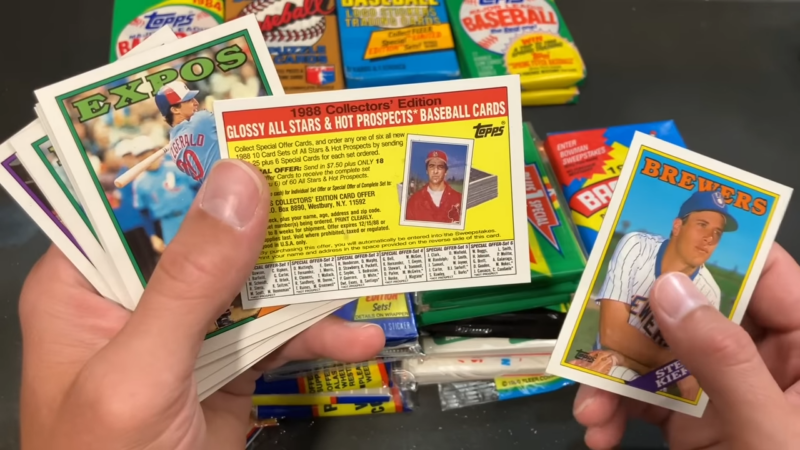How to Tell If a Baseball Card Is a Reprint: Key Identification Tips
To determine if a baseball card is a reprint, examine its size, paper quality, color, print marks, and authenticity features. Check for signs like a glossier finish, modern cardstock, or incorrect dimensions.
Assembling a baseball card collection can be a thrilling pursuit, especially when it includes vintage and potentially valuable cards. Identifying a reprint from an original is crucial for collectors who aim to invest in genuine memorabilia. Reprints often hold sentimental value but lack the monetary value of authentic cards.
Ensuring the authenticity of your collection involves close inspection and sometimes consulting with experts. The market for baseball cards is vast, with reissues and replicas often circulating alongside the originals. Collectors must be vigilant and well-informed to safeguard the integrity of their collections. Focusing on specific characteristics such as print quality and material can greatly aid in distinguishing reprints from original baseball cards.

Credit: www.ngbaseball.org
Unraveling The Secrets Of Baseball Card Authenticity
The thrill of collecting baseball cards spans generations. Yet, potential pitfalls await. Discerning real from reprint is crucial. Collectors must know the telltale signs of an original. Let’s dive into the methods that help verify a card’s authenticity.
The Surge Of Reprints In The Market
Reprints, or replicas of original baseball cards, flood the market. This can make true finds harder to spot. Collectors seek vintage, historical, and rare cards. The value of these cards lies in their authenticity and condition. Without real cards, there is no true collection.
- A sharp rise in reprints affects card prices.
- Knowledge of reprints keeps a collector’s investments safe.
- Experts use professional tools and techniques to spot fakes.
The Importance Of Knowing Genuine From Fake
Differentiating an original card from a reprint is essential. True cards have distinct characteristics. Reprints often lack these features or replicate them poorly. The size, color, texture, and even smell can help verify a card’s history.
- Check the card size against known measurements.
- Examine the color depth and alignment.
- Inspect for typographical errors or updated copyright information.
- Consider a third-party authentication service.
Smart collecting means staying informed. Spotting the subtle signs of a reprint can safeguard your collection. Cherish the history and legacy of baseball. Seek the genuine, and enjoy the unique story each original card tells.

Credit: www.cardboardconnection.com
The History And Value Of Original Baseball Cards
The History and Value of Original Baseball Cards ignites a passion among collectors and sports enthusiasts alike. An original from the past stands not only as a piece of history but also as a potentially valuable asset. Discerning between an original and a reprint holds immense importance in the collecting world.
Tracing Back To The Golden Eras
Original baseball cards serve as snapshots into the golden eras of baseball. They emerged in the late 19th century, finding their way into packages of tobacco and confectionery products. Baseball cards peaked in popularity through the mid-20th century, known as the ‘Vintage Era.’
- T206 Honus Wagner: Printed during the 1909-1911 seasons, commands millions today.
- 1933 Goudey Babe Ruth: Among the most iconic cards of the time.
- Topps cards of the 1950s: Marked the beginning of the modern baseball card era.
These treasures tracked player careers, showcasing design evolutions and serving as a history lesson to those who hold them.
What Makes Originals A Treasure Trove
Original baseball cards are highly sought after for several compelling reasons. They represent a tangible connection to baseball legends, mirror societal changes over time, and, above all, are rare—and with rarity often comes value.
| Card Characteristics | Value Implications |
|---|---|
| Player’s popularity | Direct impact on demand and price |
| Condition | Mint condition multiplies the value |
| Scarcity | Less availability can equal more value |
| Era & Print Details | Original print run cards may command premiums |
Cards in mint condition, from iconic series or featuring legendary players, turn them into valuable artifacts. Collectors often seek professional grading services to verify the authenticity and condition, further ensuring their value. This preserves the legacy, marking these originals as true treasures.
The Common Characteristics Of Reprint Cards
Figuring out if a baseball card is a reprint can be tricky. Originals hold high value among collectors. Reprints, on the other hand, might have sentimental value but their monetary value is low. Knowing the common characteristics can save fans time and money.
Tell-tale Signs Of Modern Printing
Reprints often have giveaways that expose them. Check for these top signs:
- Sharpness of text: Modern methods often lead to clearer, sharper fonts than those found on vintage cards.
- Color inconsistencies: Original cards can show variations in color due to age, but reprints may have overly vivid hues.
- Card gloss: Older cards had less shine while reprints might look more ‘finished’ due to modern coating methods.
- Dot matrix patterns: Use a magnifying glass to spot the dot patterns of modern printers that old presses didn’t create.
Identifying The Feel Of A Reprint
Touch can reveal a reprint’s true nature:
- Thickness and rigidity: Compare the card with a known original. Reprints may be thicker or stiffer.
- Texture: Run your fingers over the card. A reprint may feel smoother than an original’s textured surface.
- Card edges: Examine the cut. Modern cutting leaves cleaner edges compared to originals.
A hands-on approach can often detect a reprint before buying or trading.

Credit: m.youtube.com
Print Quality: The Devil Is In The Details
Detecting a reprint of an original baseball card involves scrutinizing print quality. Small details can reveal big secrets about a card’s authenticity. This section will guide you through spotting these subtle differences.
Inconsistencies In Image And Color Quality
Original cards display sharp, consistent images with vibrant colors. Reprints might look blurry or faded. To spot these signs, compare the card to known originals.
- Fuzzy Images: Lines and edges that are not clear.
- Off Colors: Colors that seem unusual or dull.
- Details Missing: Small elements that may be lost in reprints.
Observing The Printing Dots Under Magnification
Examining a card under a magnifying glass can reveal much about its origins. Original cards were often printed with particular patterns of dots. Let’s focus on this:
- Use a Magnifying Tool: A loupe or a microscope works best.
- Check Dot Patterns: Authentic cards have specific dot structures.
- Look for Dot Shape: Reprints may show dots that are irregular.
Understanding these nuances is essential to determining a card’s legitimacy. It requires a careful eye and attention to detail. Keep these tips in mind when inspecting your baseball cards!
Text And Typography: Cracking The Code
Determining if a baseball card is a reprint involves a keen eye, especially when it comes to text and typography. Original cards and reprints often differ in subtle ways that are most noticeable in the font and text layout. Below are two critical areas in which these differences may be revealed.
Font Variations In Reprints
Baseball card collectors know that the devil is in the details. Original cards have specific fonts that were used during their initial production. Reprints, on the other hand, often bear slight discrepancies. They can occur due to modern printing techniques or a lack of access to the original fonts. Look for these signs:
- Character shape: Check if the letters and numbers match the style of original cards from the same era.
- Font weight: Analyze whether the text is thicker or thinner than on genuine cards.
- Font color: Color can fade over time, so reprints may feature more vibrant text.
Misalignments And Spacing Giveaways
Proper alignment and spacing are telltale signs of an original card. Authentic cards maintain consistent text placement. Reprints might show errors not present in the originals. When inspecting a card, consider these points:
- Check the borders of the text. Expect asymmetry in reprints.
- Look for unusual gaps. Originals have evenly spaced characters and words.
- Compare with verified originals. Even minor differences can be significant indicators.
Cards that show misaligned text or imperfect spacing often signal a reprint. Examine multiple areas of the card for these inconsistencies to make an accurate judgment.
Physical Inspection: Touch And Texture
For collectors and enthusiasts, the authenticity of a baseball card is a top priority. One effective way to determine if a baseball card is an original or a reprint is through physical inspection, focusing on touch and texture. This hands-on approach provides telltale signs of a card’s legitimacy. Here’s how to inspect a card’s physical attributes.
The Paper Stock Difference
Original baseball cards have a distinctive paper stock that sets them apart from reprints. Authentic cards typically use a certain type of cardboard that can feel stiff and have a specific weight. In contrast, reprints might feel flimsy or have a glossy finish not present on originals. To check for authenticity:
- Compare the card’s weight to known originals.
- Check for uniform color and aging signs consistent with the card’s era.
- Feel for texture; originals may have minute imperfections in the cardboard.
Edge And Corner Examination
Edges and corners of a baseball card can reveal a lot about its authenticity. Original cards often have edges and corners that reflect normal wear and tear of handling over the years. Here’s what to look for:
| Feature | Original | Reprint |
|---|---|---|
| Edges | May show natural wear | Often too perfect or ‘crisp’ |
| Corners | Possibly rounded/dulled from age | Can be overly sharp or uniform |
In summary, a careful physical examination of the card’s texture, edges, and corners can provide strong clues about its origin. An authentic card will often tell its age, whereas a reprint may seem eerily perfect. Remember these tips next time you handle a vintage card, and trust your tactile senses along with your visual scrutiny.
Authentication Marks: The Hidden Indicators
Every baseball card has a story, but is it the original tale or a reprinted narrative? For collectors, authenticity means everything. Uncovering the hidden indicators can make all the difference. Finding these marks helps confirm whether you’ve got an original gem or a clever reproduction in your hands.
Manufacturer Logos And Watermarks
Original baseball cards carry distinct marks from their makers. These are like secret handshakes between the manufacturer and collectors. Look for crisp, clear logos often printed on the card’s back.
- Topps cards might have a tiny TM symbol.
- Donruss editions often include a knight and bat.
- Fleer card? Search for a stylized ‘F’ logo.
Watermarks, on the other hand, are subtle. They’re visible when held up to light. These ghostly images whisper ‘original’ softly but surely. Be keen and look closely; they’re often shy to appear at first glance.
Serial Numbers And Holograms
Serial numbers and holograms stand as gatekeepers to authenticity. Every original has a unique identifier. It’s a thumbprint whispering the card’s origin story.
- Find the serial number, often stamped in gold.
- Low numbers typically suggest a limited print run – a collector’s delight!
- Examine the hologram – a dance of light conceiving trust.
These flashy guards beam with pride on genuine items, showcasing their authenticity. Counterfeits might try to impress with fake bling, but a trained eye can spot the difference easily.
Professional Grading And Verification Resources
Entering the realm of Professional Grading and Verification Resources unlocks the doors to definitive answers regarding the authenticity of baseball cards. Simple inspection may not suffice to tell if a card is a reprint. Grading companies and online guides provide the expertise needed to discern reprints from originals.
Engaging Services Of Grading Companies
Grading companies specialize in verifying the authenticity and condition of baseball cards. By sending cards to a professional service, collectors receive an expert assessment backed by the company’s reputation.
- PSA (Professional Sports Authenticator) – Renowned for detailed evaluations.
- BGS (Beckett Grading Services) – Offers a comprehensive grading scale.
- SGC (Sportscard Guaranty Corporation) – Known for their conservative grading standards.
Cards are encased post-grading, ensuring their protection and providing a visual confirmation of the card’s legitimacy and quality grade.
Leveraging Online Authentication Guides
Authentication guides online are treasure troves of information. These guides often present detailed indicators of original cards versus reprints.
- Serial numbers: Check for matching numbers in the guide.
- Print quality: Compare print details with online exemplars.
- Card attributes: Match colors and textures to authenticated standards.
Forums and collector communities also share insights and can offer unofficial, yet valuable, opinions on a card’s authenticity.
Protecting Yourself From Scams: Buyer Beware
Stepping into the world of baseball card collecting is thrilling. Yet, caution is key. Fakes and reprints can trap unwary buyers. Let’s uncover how to safeguard investments and dodge scams.
Researching The Seller’s Reputation
Trust hinges on credibility. Begin with the seller’s history. A trustworthy seller is often open about their track record. Check feedback from other buyers. Positive reviews signal a reliable seller. Look for signs of knowledge in the seller’s descriptions. Experts in the field know the nuances of authentic cards.
- Examine seller ratings on platforms like eBay or Heritage Auctions.
- Search for online reviews or collector forums discussing the seller.
- Scrutinize the authenticity of testimonies.
Ensuring The Return Policy
Robust return policies offer buyer protection. Read the policy carefully. Understand the timeframe and conditions for returns. A clear, buyer-friendly return policy indicates seller confidence in their offerings. Do not hesitate to ask the seller directly for clarification on the return policy. Clear communication can prevent misunderstanding and loss.
- Verify the duration within which a return is possible.
- Confirm the state the item must be in for a successful return.
- Ask the seller if a certificate of authenticity is provided.
The Collector’s Mindset: Patience And Knowledge
The Collector’s Mindset: Patience and Knowledge – quintessential traits that guide enthusiasts in the fascinating world of baseball card collecting. Discerning whether a baseball card is a genuine original or a reprint requires a blend of these virtues. Patience enables a thorough investigation of a card’s authenticity, while knowledge equips collectors with the insight to make informed decisions.
The Continuous Learning Curve
Mastering the art of identifying original cards is not an overnight process. It involves a continuous journey towards knowledge. Key attributes to focus on include:
- Print technology: Understanding the printing methods used during different eras can be a telltale sign.
- Cardstock: Comparing the weight and texture to known originals helps in identification.
- Color and clarity: Originals have distinct color palettes and image sharpness that reprints often lack.
Bolster this knowledge with resources like books, online forums, and collector’s guides. This groundwork not only helps in spotting reprints but also enriches the overall collecting experience.
Networking With Other Enthusiasts
Engaging with a community of fellow collectors can significantly enhance your ability to identify reprints. Key benefits include:
- Shared experiences: Gaining insights from others’ discoveries and mistakes.
- Trade knowledge: Learning about cards from different time periods and manufacturers.
- Expert opinions: Getting a second opinion on whether a card is an original or a reprint.
Tap into social media groups, attend trade shows, and participate in online forums to connect with other passionate collectors. These interactions can be invaluable in developing the expertise necessary to spot the subtle differences between original cards and reprints.
Frequently Asked Questions For How Do You Tell If Baseball Card Is A Reprint Of An Original
How Do You Tell If A Baseball Card Is Original Or Reprint?
Check the card’s paper quality and printing details; originals often show aging signs and sharper images. Compare with verified originals for discrepancies. Serial numbers or authenticity marks indicate true vintage. Consult a professional appraiser for expert verification of an original baseball card.
How Do You Know When A Baseball Card Was Printed?
Check the card’s reverse for a printed year. If absent, research the design and player stats online to estimate the printing date. Serial numbers, if present, can also indicate the year.
How Do I Know If I Have A Short Print Baseball Card?
Check the card number against the set checklist; short prints are often listed as such. Research online databases or forums for rarity details on specific cards. Manufacturer websites may also provide information on short print runs for certain series or special editions.
Conclusion
Determining the authenticity of a baseball card involves attention to detail and a keen eye. Check for telltale signs like printing quality, cardstock, and age indicators. Seek expert advice when in doubt to ensure your collection’s integrity. Remember, a genuine passion for the game is the heart of collecting, authentic or reprint.



